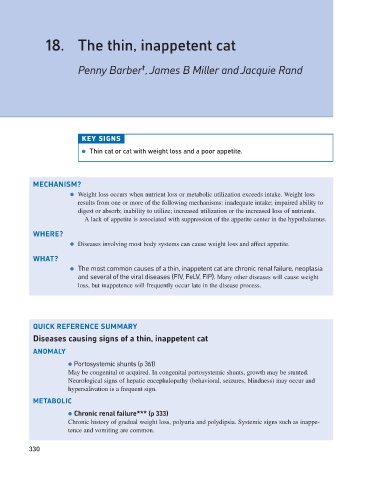Page 338 - Problem-Based Feline Medicine
P. 338
18. The thin, inappetent cat
†
Penny Barber , James B Miller and Jacquie Rand
KEY SIGNS
● Thin cat or cat with weight loss and a poor appetite.
MECHANISM?
● Weight loss occurs when nutrient loss or metabolic utilization exceeds intake. Weight loss
results from one or more of the following mechanisms: inadequate intake; impaired ability to
digest or absorb; inability to utilize; increased utilization or the increased loss of nutrients.
A lack of appetite is associated with suppression of the appetite center in the hypothalamus.
WHERE?
● Diseases involving most body systems can cause weight loss and affect appetite.
WHAT?
● The most common causes of a thin, inappetent cat are chronic renal failure, neoplasia
and several of the viral diseases (FIV, FeLV, FIP). Many other diseases will cause weight
loss, but inappetence will frequently occur late in the disease process.
QUICK REFERENCE SUMMARY
Diseases causing signs of a thin, inappetent cat
ANOMALY
● Portosystemic shunts (p 361)
May be congenital or acquired. In congenital portosystemic shunts, growth may be stunted.
Neurological signs of hepatic encephalopathy (behavioral, seizures, blindness) may occur and
hypersalivation is a frequent sign.
METABOLIC
● Chronic renal failure*** (p 333)
Chronic history of gradual weight loss, polyuria and polydipsia. Systemic signs such as inappe-
tence and vomiting are common.
330

